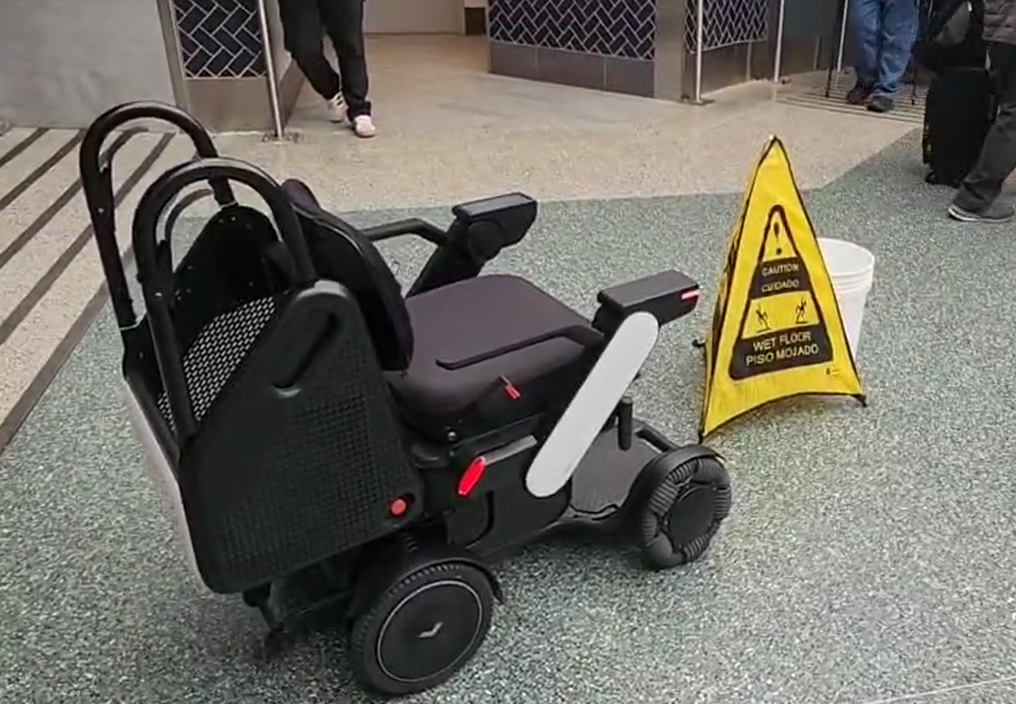The self-driving wheelchair encountered some challenges while navigating through Sea-Tac International Airport, getting stuck behind a sign and coming to a halt when faced with a temporary obstacle. These electric wheelchairs are part of a test deployment by the company Whill, which is based in California and Japan. The devices are designed to autonomously transport passengers to their gates, with the ability to detect obstacles and navigate around them without human intervention. However, the wheelchair’s response to temporary obstacles, such as a wet floor sign, posed some challenges to its autonomous function.
During the wheelchair’s journey through the airport, it encountered difficulties when faced with unexpected obstacles. In one instance, the wheelchair was stopped in its tracks by a short yellow tent and bucket marking a wet floor. The wheelchair repeatedly asked people to move and step aside until a human nearby intervened and removed the obstacles. This prompted the Alaska Airlines spokesperson to explain that the chairs are mapped and programmed to have a specific lane to reach each approved point. Temporary obstacles are detected by the sensors, triggering a standard response to address them, such as alerting people to move out of the way. However, the wheelchair’s ability to interpret these obstacles correctly and navigate around them autonomously remains a challenge.
The self-driving wheelchairs made by Whill have been deployed at multiple airports in the U.S. and abroad for test programs as well as regular use. The company aims to provide an innovative mobility solution for passengers with disabilities, offering a more independent and convenient way to navigate through airports. By incorporating autonomous technology into wheelchairs, Whill seeks to improve the overall travel experience for individuals with mobility challenges. However, the recent incident at Sea-Tac Airport highlights the need for further refinement in the wheelchair’s autonomous functions to address unexpected obstacles effectively and ensure seamless navigation through busy airport environments.
The incident at Sea-Tac Airport raises questions about the reliability and effectiveness of autonomous technology in mobility devices, particularly in complex and unpredictable environments such as airports. While autonomous wheelchairs offer a promising solution for individuals with disabilities to travel independently, the ability to navigate through crowded spaces and respond to unexpected obstacles remains a significant challenge. As technology continues to advance, companies like Whill will need to refine their autonomous systems to improve the wheelchair’s ability to adapt to changing environments and ensure passenger safety and convenience.
Despite the challenges faced by the self-driving wheelchair at Sea-Tac Airport, the incident highlights the potential of autonomous technology to transform the travel experiences of individuals with disabilities. By incorporating advanced sensors and mapping capabilities, autonomous wheelchairs can offer a safe and efficient means of transportation in busy airport environments. As companies like Whill continue to innovate and refine their autonomous mobility devices, the future of accessible and independent travel for individuals with disabilities looks promising. With further development and testing, self-driving wheelchairs could become a standard feature at airports worldwide, revolutionizing the way people with mobility challenges navigate through public spaces.
In conclusion, the self-driving wheelchair incident at Sea-Tac Airport underscores the ongoing advancements in autonomous technology and the potential challenges of implementing such systems in real-world environments. While the incident highlighted some limitations in the wheelchair’s ability to navigate around unexpected obstacles, it also demonstrated the progress that has been made in incorporating autonomous functions into mobility devices. As companies like Whill continue to refine their autonomous wheelchairs and address issues such as obstacle detection and response, the future of accessible and independent travel for individuals with disabilities looks increasingly promising. By leveraging innovative technology and design, autonomous wheelchairs have the potential to revolutionize the way people with mobility challenges navigate through public spaces and enhance their overall travel experience.












